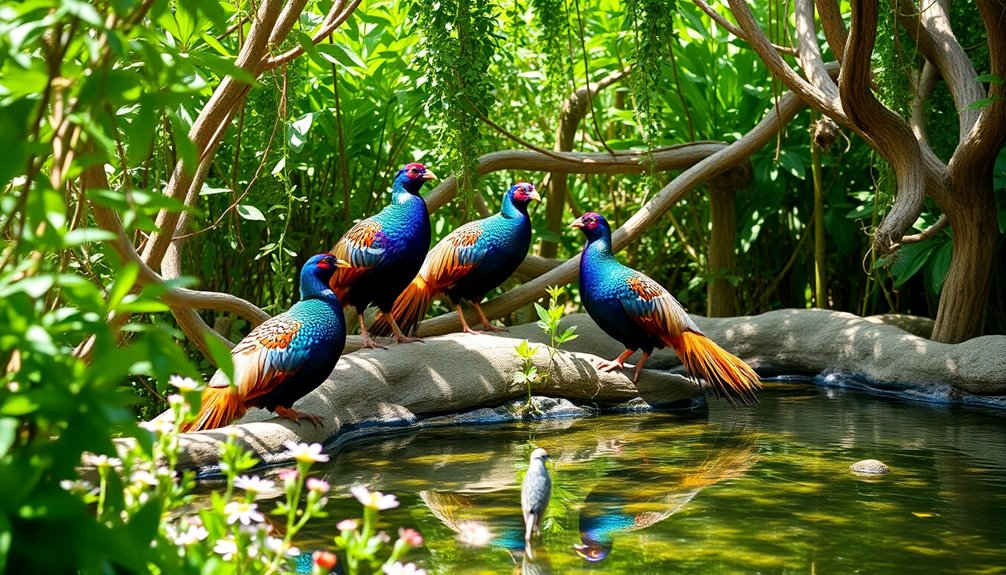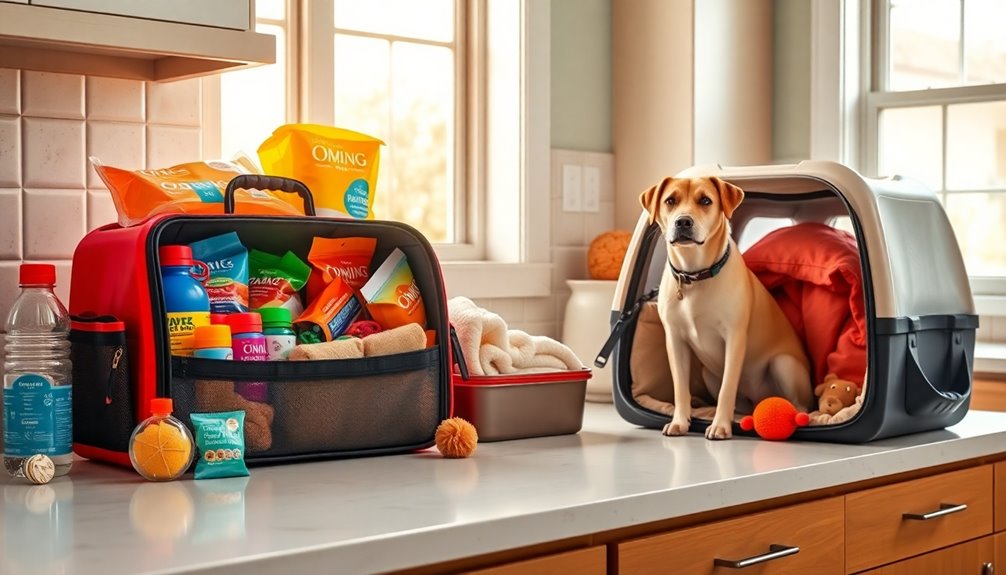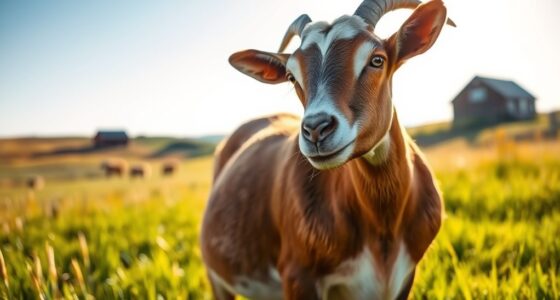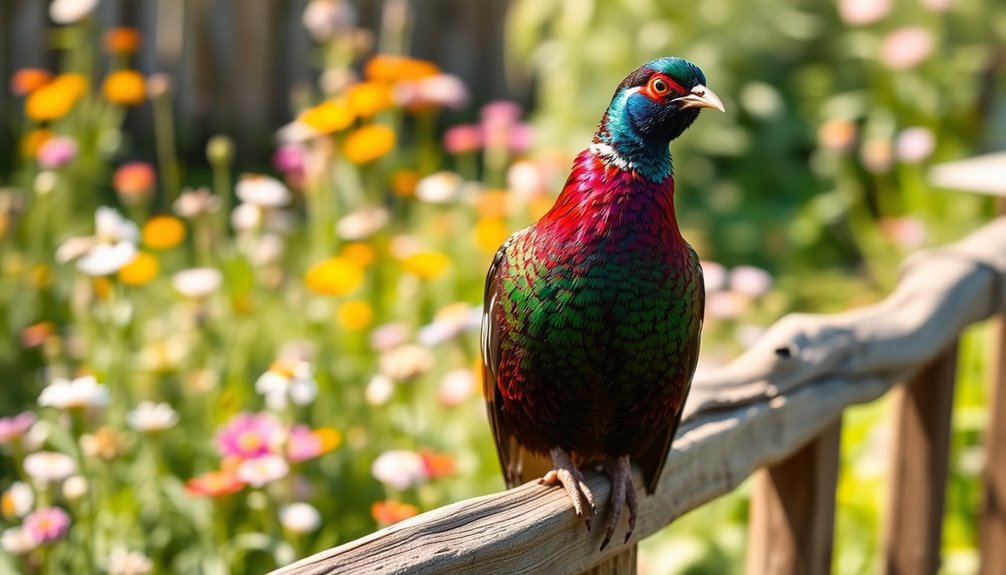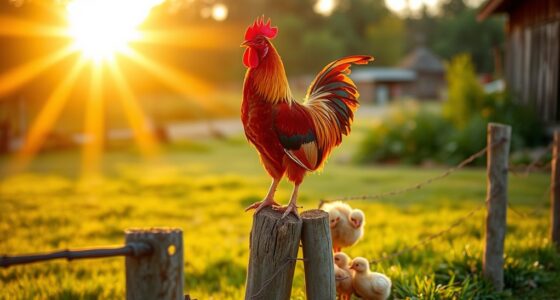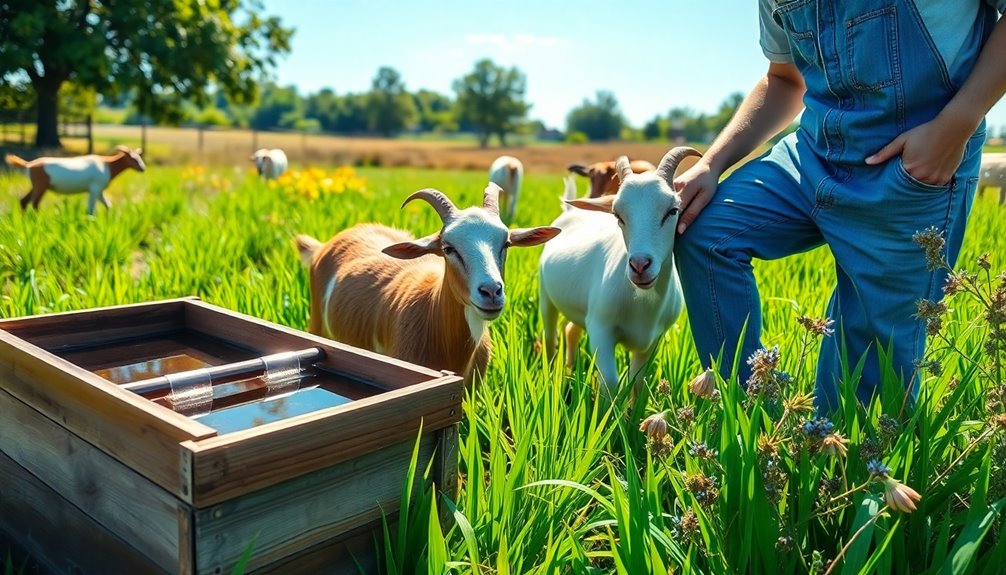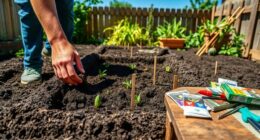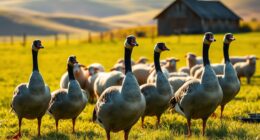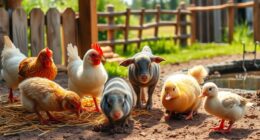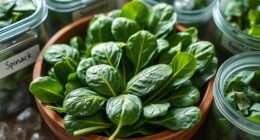Designing the perfect pheasant aviary means ensuring it's safe, spacious, and lets your feathered friends thrive. Aim for dimensions of at least 8' x 12' x 7' for about ten pheasants. Use sturdy materials like galvanized steel and PVC-coated mesh to keep them secure. Adding bird-safe plants and natural elements can mimic their natural habitat, while proper ventilation and lighting are essential for their health. Remember to incorporate accessible entry points for easy cleaning and maintenance. Want to create an aviary that your pheasants adore? There's more to take into account to make it their ideal home!
Key Takeaways
- Ensure the aviary dimensions are 8' x 12' x 7' to provide sufficient space for up to 10 pheasants.
- Use durable materials like galvanized steel and PVC-coated wire mesh to enhance safety and weather resistance.
- Incorporate bird-safe plants and natural elements like logs for climbing, hiding, and enrichment within the aviary.
- Maintain proper ventilation with strategically placed openings and consider using fans for fresh air circulation.
- Regularly monitor social dynamics and provide adjustments to reduce stress and aggression among the pheasants.
Aviary Specifications
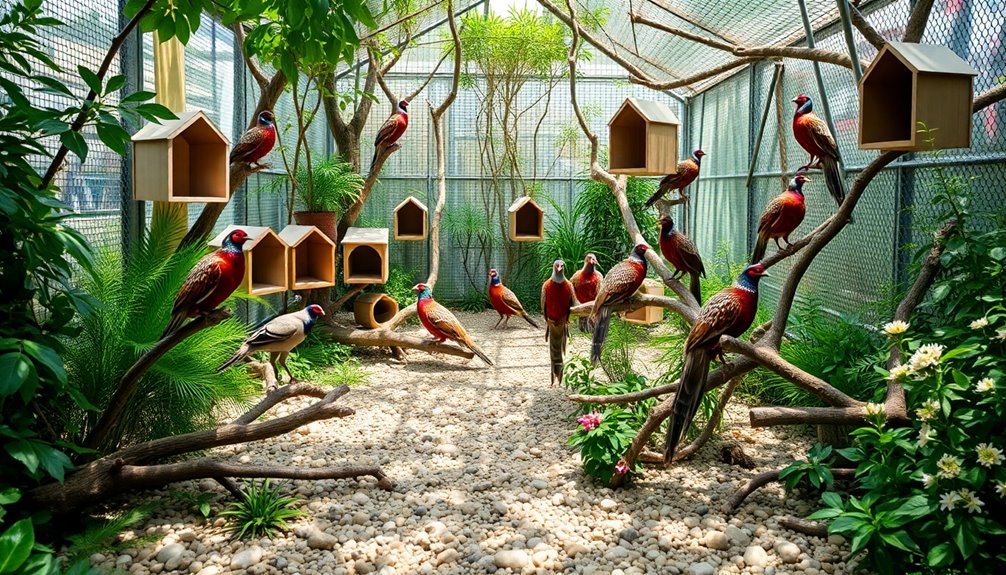
When designing your pheasant aviary, you'll want to contemplate the dimensions and capacity carefully. The proposed size of your aviary should be around 8' x 12' x 7', which offers ample space for a pair or trio of pheasants.
To guarantee a harmonious environment, make sure you limit the capacity to about 10 pheasants. This helps reduce aggression and feather picking, especially during the breeding season when birds may display heightened territorial behaviors.
Using materials like galvanized steel or PVC-coated wire mesh not only enhances safety but also provides comfort for your birds.
Bird Capacity and Management
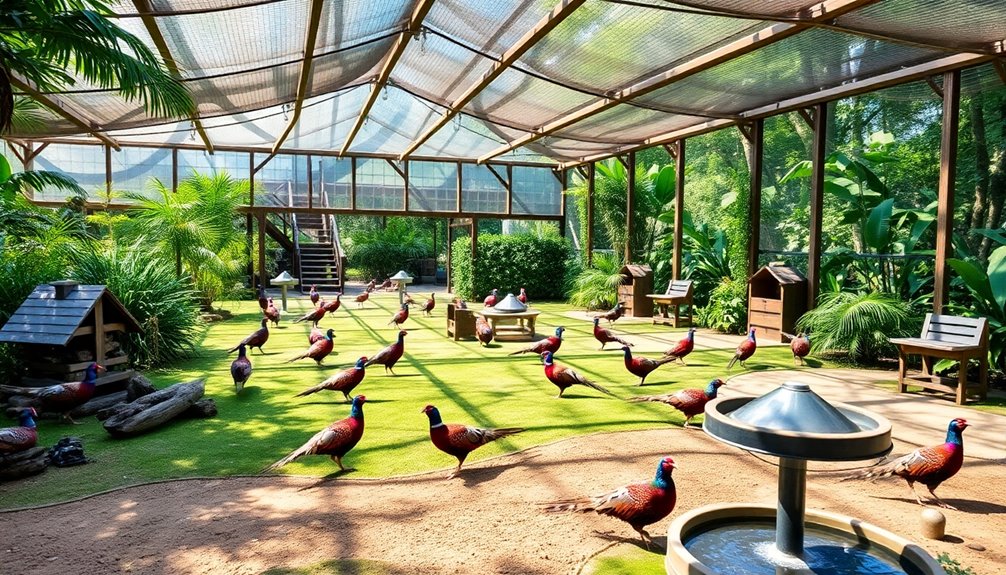
Managing bird capacity in your pheasant aviary is crucial for maintaining a healthy and harmonious environment. For an 8' x 12' x 7' aviary, keeping around 10 pheasants is recommended to minimize aggression and feather picking.
While a pair or trio can coexist peacefully, mixing multiple species of birds isn't advisable, as it can lead to stress and conflict.
It's important to monitor social dynamics closely; if you notice aggression, consider using blinders or making habitat adjustments.
Isolation can negatively affect their well-being, so make sure they've enough space and enrichment.
Keep a watchful eye on stress factors, as managing these will promote the overall welfare of your feathered friends, making certain they thrive in their big enough home.
Materials Selection
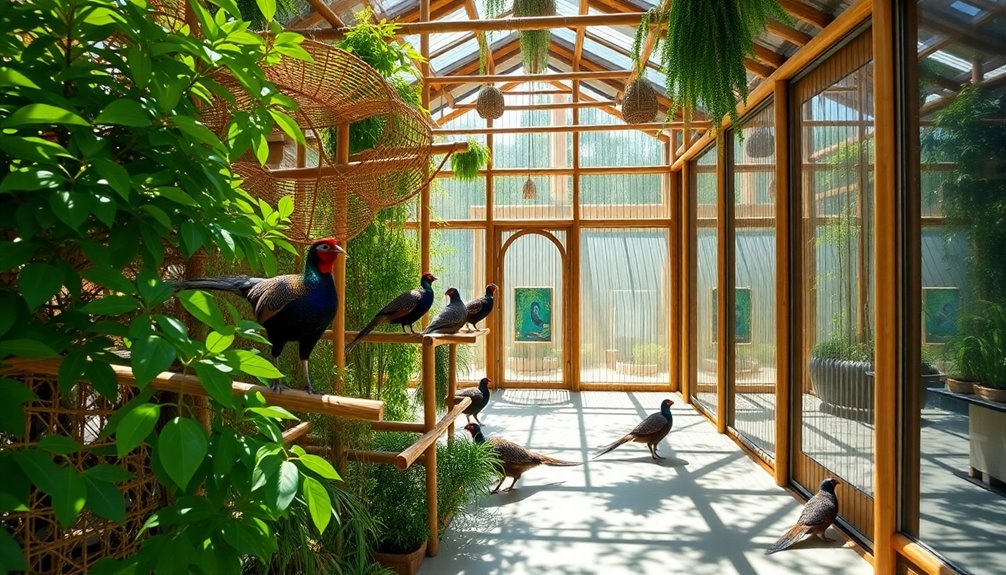
When selecting materials for your pheasant aviary, focus on durability and weather resistance to guarantee a safe environment.
Galvanized steel and aluminum are excellent choices that can withstand the elements while deterring potential predators.
You'll also want to take into account PVC-coated wire mesh for safety, as it protects the birds without compromising their comfort.
Durable Material Options
How do you choose the best materials for your pheasant aviary? Start by considering galvanized steel, aluminum, or PVC-coated wire mesh. These materials are durable and resist rust, ensuring your aviary withstands various conditions.
Additionally, stainless steel bird netting is ideal for deterring predators while standing up to the elements. It's essential to select materials that are easy to clean and maintain, as hygiene plays a significant role in your birds' health and aviary longevity.
Remember to prioritize non-toxic options for perches and accessories, ensuring your feathered friends remain safe. Ultimately, robust materials will guarantee structural integrity and provide a comfortable, secure environment for your pheasants.
Weather Resistance Importance
Choosing the right materials for your pheasant aviary isn't just about durability; it's also about how well those materials can handle the elements.
Selecting galvanized steel, aluminum, and PVC-coated wire mesh guarantees your aviary withstands harsh weather while keeping your birds safe. Stainless steel netting not only enhances weather resistance but also plays a role in deterring predators, which is crucial for your pheasants' security.
Opt for materials that allow for easy maintenance and cleaning, preventing harmful bacteria buildup exacerbated by weather conditions.
Incorporating a double mesh layer can provide extra protection against environmental factors and enhance safety against potential threats. Proper material selection greatly contributes to the aviary's longevity, minimizing weather-related repairs and guaranteeing a comfortable home for your feathered friends.
Predator Deterrent Features
To effectively safeguard your pheasant aviary from potential threats, selecting the right materials is essential. Utilizing galvanized steel, aluminum, and PVC-coated wire mesh guarantees durability and weather resistance while effectively deterring predators.
Consider adding a double mesh layer for enhanced protection against predatory animals. Stainless steel bird netting is another robust option, preventing access while maintaining visibility for observation.
Don't forget the ground surface; incorporating a mesh layer prevents rodents and small predators from burrowing in.
Regularly inspecting and maintaining these materials helps identify wear and tear, guaranteeing your predator deterrent features remain effective.
Perches and Accessories
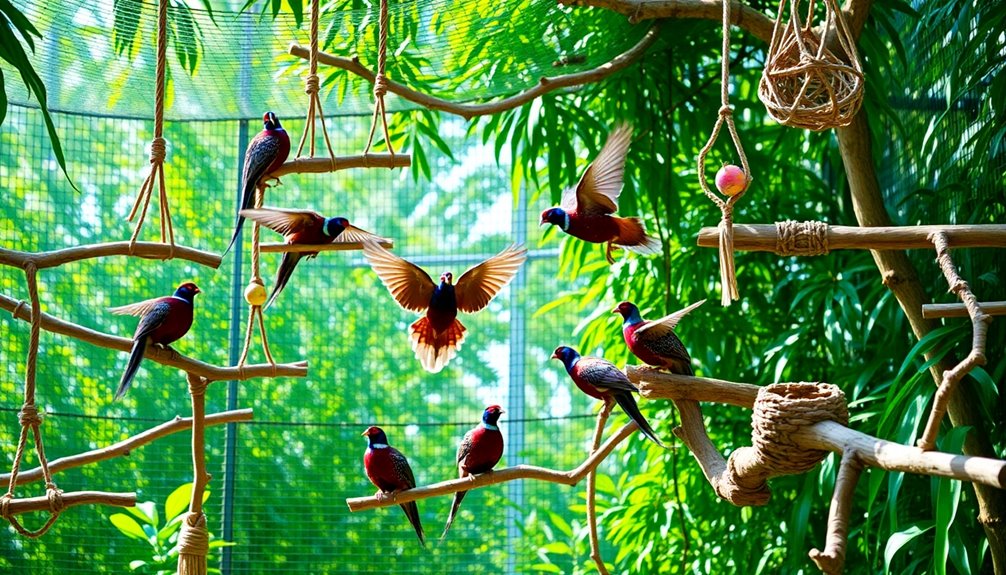
In designing a pheasant aviary, incorporating a variety of perches and accessories is essential for the birds' well-being. Providing perches at different heights, around 3-4 feet for larger birds, promotes foot health and encourages natural behaviors.
Using natural materials like branches helps create a stimulating environment that mimics their habitat.
To enhance their quality of life, consider adding these accessories:
- Swings – These encourage movement and playfulness.
- Ladders – They promote climbing and physical activity.
- Toys – Engaging toys can reduce boredom and aggression.
Regularly inspect and replace worn accessories to guarantee safety, and space perches at least 2 feet apart to prevent injuries from overcrowding.
Plants and Natural Elements
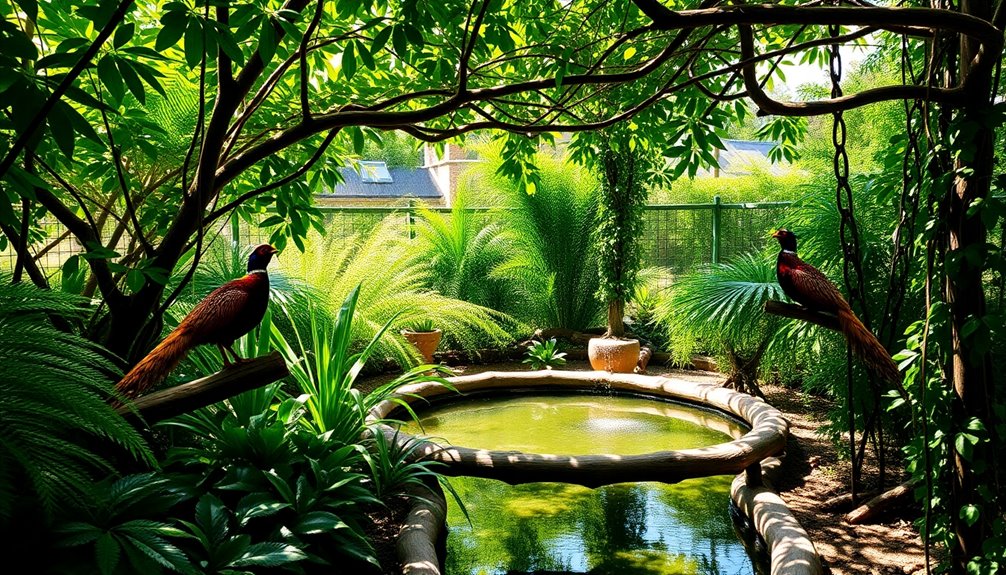
When creating your pheasant aviary, selecting bird-safe plants is essential for keeping your feathered friends healthy.
By incorporating these plants and natural elements, you can simulate their natural habitat, making it a more stimulating environment. Additionally, consider using essential oils that are safe for birds to enhance the overall ambiance and promote well-being.
Don't forget that regular maintenance is key to ensuring the plants thrive and enhance the aviary's aesthetics.
Bird-Safe Plant Selection
Selecting the right plants for your pheasant aviary is essential for guaranteeing the health and safety of your birds. Choose bird-safe species to avoid toxicity and enhance their environment. Here are three great options:
- Hibiscus – This vibrant plant adds color and is safe for your birds.
- Marigold – Not only beautiful, but marigolds also deter pests.
- Non-toxic ferns – These provide natural cover while being durable for pecking.
Incorporating live plants improves aesthetics and mimics natural habitats.
Remember to regularly research and verify plant safety, as some common garden varieties can be harmful. Use robust plants like bamboo or hardy grasses, and maintain them by pruning and checking for pests to guarantee a safe and stimulating aviary for your pheasants.
Natural Habitat Simulation
Creating a natural habitat simulation in your pheasant aviary is essential for the birds' well-being. Incorporating live plants and branches will provide a stimulating environment that mimics their natural habitat, helping to reduce stress.
Be sure to research and select bird-safe plants to avoid toxicity and guarantee a safe space for your pheasants. Adding natural elements like rocks and logs will create climbing and resting spots, encouraging physical activity and exploration.
A variety of perches made from natural materials not only supports foot health but also enhances the aviary's aesthetic appeal. By designing this enriched environment, you promote healthier, happier birds who can thrive in their new home.
Maintenance of Plant Life
Regularly maintaining the plant life in your pheasant aviary is essential for guaranteeing a vibrant and safe environment.
Healthy plants prevent toxicity and contribute to the overall well-being of your birds. Here are some key maintenance tasks to keep in mind:
- Prune and Water: Regularly prune overgrown plants and guarantee they're adequately watered to promote healthy growth.
- Research Bird-Safe Plants: Before introducing any new plants, make certain they're safe for pheasants to avoid harmful effects.
- Incorporate Natural Elements: Adding rocks and logs can enhance the aviary's aesthetics and provide climbing and resting spots for your birds.
Accessibility Features
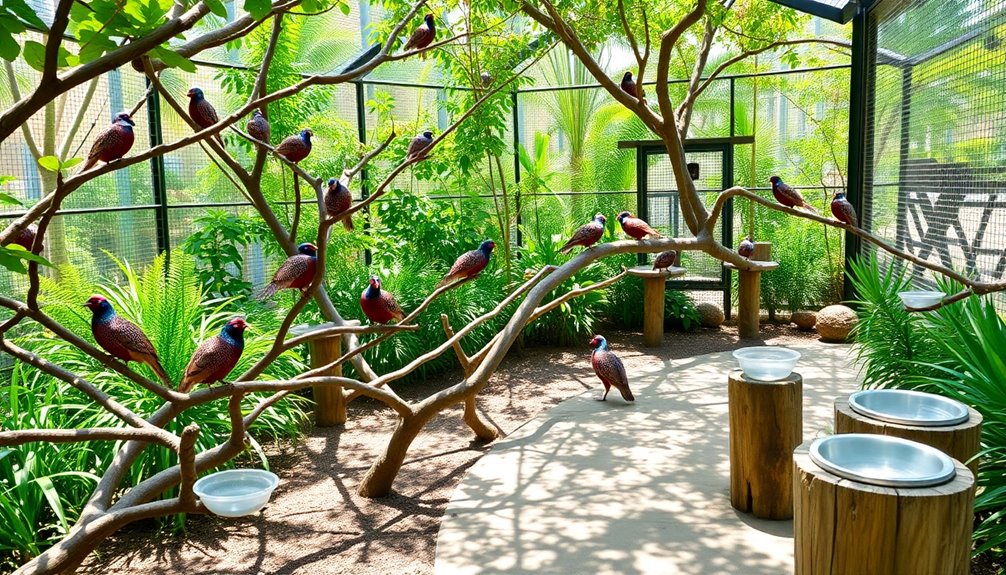
When designing a pheasant aviary, you'll want to guarantee accessibility features are prioritized for both the birds and caretakers.
Start by incorporating a double door system to prevent accidental escapes during cleaning and maintenance. Design an entrance that includes a smaller door or window, allowing birds to enter and exit comfortably.
Make certain pathways within the aviary are clear and unobstructed, facilitating easy movement for both birds and caretakers. Create a walkthrough space that simplifies cleaning tasks while providing efficient access to food, water, and nesting materials.
Finally, regularly inspect all entry points to make sure they're secure, preventing potential escapes or safety hazards for your feathered friends.
These features will make your aviary functional and safe for everyone involved.
Ventilation and Lighting
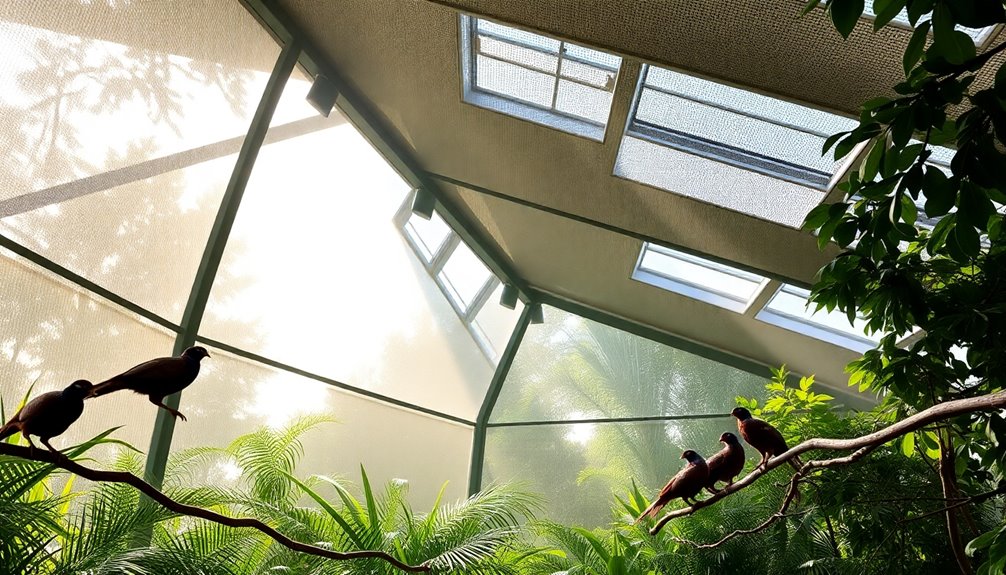
To guarantee your pheasant aviary thrives, prioritizing proper ventilation and lighting is essential.
Adequate ventilation guarantees fresh air circulation, preventing harmful fume buildup that can jeopardize your birds' health. Strategically placed openings will maintain airflow while keeping your pheasants safe.
Natural light promotes natural behaviors and supports their physiological needs, but if natural light falls short, consider these options:
- Install windows to maximize sunlight exposure.
- Use artificial lighting during winter months to mimic natural daylight.
- Regularly monitor air quality and light exposure to prevent stress and guarantee a healthy environment.
Frequently Asked Questions
What Plants Are Good for Pheasant Aviary?
When selecting plants for your pheasant aviary, focus on bird-safe options like sunflowers, clover, and dandelions. These provide nutritious greens and seeds.
Incorporate native shrubs like hawthorn and blackthorn for natural cover and nesting sites. You can also add non-toxic herbs, such as basil and parsley, for additional food sources.
Make sure the plants you choose are sturdy enough to handle pheasant activity and avoid any that could be toxic to them.
What Direction Should an Aviary Face?
Imagine your aviary basking in the sun, its occupants thriving in a warm, vibrant space. To achieve this, you should face it south or southeast. This orientation maximizes sunlight, essential for your birds' health.
Keep it sheltered from prevailing winds to protect them from harsh weather. Avoid placing it near tall trees or structures that cast shade, ensuring your feathered friends get plenty of light and room to flourish.
How Much Does It Cost to Build an Aviary?
Building an aviary can cost anywhere from $1,000 to $3,000, depending on the materials and size you choose.
Basic materials like galvanized steel or PVC-coated wire mesh typically range from $1 to $3 per square foot.
Factor in additional expenses for flooring, which can be $0.50 to $2 per square foot, plus around $100 to $500 for accessories like perches.
Don't forget ongoing maintenance costs for cleaning and health checks, too.
What Should Be on the Floor of an Aviary?
You might think concrete's the best choice for an aviary floor, but it makes cleanup a hassle and can be harsh on your birds' feet.
Opt for sand instead; it's easy to clean and comfortable for your feathered friends. Don't forget to add a mesh layer underneath to keep pesky rodents out.
Consider elevating some areas for planting; they'll enhance the space and provide natural enrichment while ensuring everything stays safe for your birds.
Conclusion
Creating the perfect aviary for your pheasants is like crafting a vibrant sanctuary where colorful feathers dance among lush greenery. Imagine the soft rustle of leaves as gentle breezes weave through their home, while sunlight filters through, casting playful shadows. By thoughtfully considering each element—from spacious perches to natural plants—you'll provide a haven that nurtures their spirit and showcases their beauty. So, roll up your sleeves, and let your vision take flight, bringing joy to both you and your feathered friends.

